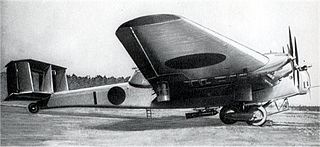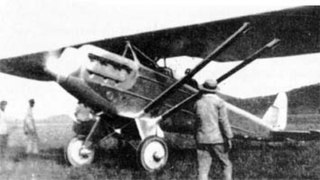
The Mitsubishi Ki-20 is a Japanese bomber variant of the Junkers G.38 airliner. Mitsubishi manufactured six aircraft under license from Junkers. These aircraft, designated Army Type 92 Heavy Bomber, served through the 1930s. During World War II, the Ki-20 served in a variety of transport and support roles.

The Mitsubishi Ki-1, also known as Mitsubishi Army Type 93 Heavy Bomber, was a bomber built by Mitsubishi for the Imperial Japanese Army in the 1930s. The Ki-1 design was heavily based on the Junkers K 37 and a mockup was ready in August 1932, with the first prototype being finished in March 1933.

The Kawasaki Army Type 88 Reconnaissance Aircraft was a Japanese single-engined biplane designed for Kawasaki by Richard Vogt. Originally known by its company designation KDA-2, it was accepted by the Imperial Japanese Army as the Type 88 Reconnaissance Aircraft. The Type 88 number was designated for the year the aircraft was accepted, which was the year 2588 in the Japanese imperial year calendar, or 1928 in the Gregorian calendar. The basic design was modified into the Type 88 Light Bomber that was used in combat over China in the Second Sino-Japanese War. The Type 88 was built in large numbers and remained in service until 1940.

The Kawasaki Ki-3 was a light bomber built by Kawasaki Kōkūki Kōgyō K.K. for the Imperial Japanese Army in the 1930s. It was the last biplane bomber design to be produced for the Imperial Japanese Army Air Force, and saw combat service in Manchukuo and in north China during the early stages of the Second Sino-Japanese War.
The Kawasaki Ki-5 was an experimental low-wing monoplane fighter aircraft designed for the Imperial Japanese Army Air Force. It first flew in February 1934, but was never produced for actual use. It was the last Japanese design led by Richard Vogt before he returned to Germany.
The Nakajima Ki-19 was an unsuccessful attempt by Nakajima Aircraft Company to meet a 1935 requirement issued by the Japanese government for a modern bomber to replace the Mitsubishi Ki-1 heavy bomber.

The Kawasaki Ki-28, World War II Allied reporting name "Bob", was an experimental fighter aircraft designed for the Imperial Japanese Army and meant as a replacement for the Kawasaki Ki-10. It flew in 1936, but was never produced for actual use as the Army chose the Nakajima Ki-27.

The Mitsubishi Ki-33 was an experimental monoplane fighter aircraft designed for the Japanese Imperial Army. Two prototypes flew in 1936 but the design never entered production.

The Mitsubishi Army Type 92 Reconnaissance Aircraft (九二式偵察機) was a Japanese short-range reconnaissance aircraft of the 1930s designed by Mitsubishi for the Imperial Japanese Army Air Force. A total of 230 were built, serving between 1933 and 1936. A parasol monoplane, the Type 92 was the first military aircraft powered by an engine both designed and manufactured in Japan to enter service.
The Nakajima LB-2 was a long-range, land-based bomber developed in Japan for use by the Imperial Japanese Navy. When rejected for military service, the sole prototype was converted into an airliner and, known as the Akatsuki-go, was operated by Manchukuo National Airways.
The Nakajima C3N-1 was a prototype Japanese carrier-based reconnaissance aircraft of the 1930s. A single-engine monoplane with a fixed undercarriage, although only two examples were built, they were both used operationally, carrying out land-based reconnaissance missions during the Second Sino-Japanese War.
The Aichi AB-4 was a Japanese flying boat of the 1930s. A single engined biplane, the AB-4 was intended to carry out night reconnaissance for the Imperial Japanese Navy. Six were built and accepted into service as the Experimental 6-Shi Night Reconnaissance Flying boat, three of which were converted to civil transports.
The Nakajima B3N was a prototype Japanese carrier-based torpedo-bomber aircraft of the 1930s. A single-engined biplane with a crew of three, it was unsuccessful, only two being built.
The Aichi AB-6, or Aichi Experimental 7-Shi Reconnaissance Seaplane, was a prototype Japanese reconnaissance floatplane. It was a single-engined, three-seat biplane intended for the Imperial Japanese Navy, but only one was built, the rival aircraft from Kawanishi, the E7K being preferred.
The Aichi F1A was a prototype Japanese floatplane of the 1930s. A single-engined biplane, the F1A was intended as a short-range observation aircraft suitable for operation off the Imperial Japanese navy's warships, but only two were built, the Mitsubishi F1M being selected instead.

The Mitsubishi G1M was a long-range twin-engined attack bomber built by Mitsubishi for the Imperial Japanese Navy in the 1930s.

The Kawasaki KDA-3 was a single-engine, parasol wing, single seat experimental fighter aircraft designed by Dornier engineer Dr. Richard Vogt and built by Kawasaki for the Japanese Imperial Army, first flying in 1928. The KDA-3 was built to replace the Ko-4 but only three prototypes were built and it was not ordered into production.

The Mitsubishi 2MB2 or Experimental Washi-type Light Bomber was a prototype Japanese single-engined biplane light bomber of the 1920s. A single example was built for the Imperial Japanese Army, but no production followed.
The Nakajima D3N was a Japanese carrier-based dive bomber of the 1930s. Three prototypes were built for the Imperial Japanese Navy, but no production followed, with the Aichi D3A being selected instead.

The Kawasaki C-5 was a 1930s Japanese civil high speed long range monoplane built for the Japanese Asahi Shimbun newspaper to gather and disseminate news across the Japanese empire.











